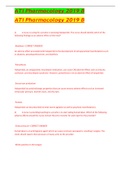-
1. Exam (elaborations) - Ati fundamentals final exam question and answers {graded a}
-
2. Exam (elaborations) - Ati pharmacology pre-assesment test exam question and answers 2021
-
3. Exam (elaborations) - Ati pediatric proctored test bank latest 2021/uworld newborn a a a latest 2021 test b...
-
4. Exam (elaborations) - Ati pediatric proctored test bank latest 2021/uworld maternity a a a test bank latest...
-
5. Exam (elaborations) - Ati comprehensive practice test 2021
-
6. Exam (elaborations) - Ati pharmacology complete exam correctly answerd questions 2021
-
7. Exam (elaborations) - Ati pharmacology online practice 2019
-
8. Exam (elaborations) - Ati pediatric proctored exam 2020/2021
-
9. Exam (elaborations) - Ati fundamental proctored exam 2019 complete exam question and answeres graded a
-
10. Exam (elaborations) - Ati pharmacology – proctored review exam questions and answeres
-
11. Exam (elaborations) - Nr 293 ati pharmacology final review_2020 – chamberlain college of nursing{ graded...
-
12. Exam (elaborations) - Ati pediatric proctored exam 2020/2021 questions and answers with explanations
-
13. Exam (elaborations) - Ati pediatrics proctored exam
-
14. Exam (elaborations) - Ati pn fundamentals proctored exam (11 latest versions, 2021) / pn ati fundamentals p...
-
15. Exam (elaborations) - Ati leadershhip exam 2022 graded a
-
16. Exam (elaborations) - Ati leadership 100 preguntas an a grade exam
-
17. Exam (elaborations) - Ati fundamentals quiz 1 exam 2022 a grade
-
18. Exam (elaborations) - Ati fundamentals of nursig exam questions and answers
-
19. Exam (elaborations) - Ati comprehensive retake pn2 exam 2022 questions and answers
-
20. Exam (elaborations) - Ati leadership exam questions and answers 2022
-
21. Exam (elaborations) - Ati comprehensive c.180 questions with answers-latest update
-
22. Exam (elaborations) - ati pharmacology final exam review exam 2022 [with rationale}
-
23. Exam (elaborations) - a ti pharmacology pre-assessment quiz
-
24. Exam (elaborations) - Ati pharmacology exam questions and answers 2022 a grade
-
25. Exam (elaborations) - Ati leadership practice a exam 2022
-
26. Exam (elaborations) - Ati fundamentals proctored exam | 100 questions and answers | latest 2020 / 2021
-
27. Exam (elaborations) - Pn vati pharmacology exam 2022 .updated
-
28. Exam (elaborations) - Ati fundamental practice exam 2022 a grade
-
29. Exam (elaborations) - Ati_pharmacology_2019_b__pharmacology_practice_2019_a_flashcards
-
30. Exam (elaborations) - Ati pharmacology 2022 e study guide
-
31. Exam (elaborations) - Ati pharmacology proctored 2019 retake 1 exam a grade
-
32. Exam (elaborations) - Ati pharmacology proctor&tab;new updated exam questions and answers docs 2021
-
33. Exam (elaborations) - Ati pharmacology proctored exam latest 2020/2021
-
34. Exam (elaborations) - 1.&tab;ati pharmacology review practice questions and answers 2022
-
35. Exam (elaborations) - Ati pharmacology 2019 b
-
36. Exam (elaborations) - Nur 3145 ati pharmacology exam 2022 a grade miami dude
-
37. Exam (elaborations) - Ati comprehensive fundamentals retake 2019 graded a+(download to score a)
-
38. Exam (elaborations) - Ati comprehensive exam questions and answers graded a
-
39. Exam (elaborations) - Ati - comprehensive c 2019 exam questions and answers
-
40. Exam (elaborations) - Ati comprehensive predictor exam questions and answers graded a
-
41. Exam (elaborations) - Ati comprehensive predictor
-
42. Exam (elaborations) - Ati comprehensive predictor rn-exit exam
-
43. Exam (elaborations) - Ati rn vati comprehensive predictor 2019 form b
-
44. Exam (elaborations) - Ati comprehensive practice b, ati comprehensive final quiz, rn comprehensive predicto...
-
45. Exam (elaborations) - Focus review 2019 ati comprehensive exit exam
-
46. Exam (elaborations) - Ati comprehensive predictor study this one
-
47. Exam (elaborations) - Focus review 2019 ati comprehensive exit exam
-
48. Exam (elaborations) - Ati pharmacology proctor 2019
-
49. Exam (elaborations) - Ati pharmacology proctored
-
50. Exam (elaborations) - Ati pharmacology proctored
-
51. Exam (elaborations) - Ati pharmacology quiz
-
52. Exam (elaborations) - Ati pharmacology quiz
-
53. Exam (elaborations) - Ati pharmacology introduction quiz
-
54. Exam (elaborations) - Ati pharmacology dynamic quiz
-
55. Exam (elaborations) - Ati comprehensive predictor 2019 a with rationale
-
56. Exam (elaborations) - Ati leadership proctored&tab;&tab;exam latest 2021/2022&tab;graded a 70&tab;questions and answers
-
57. Exam (elaborations) - Ati pediatric proctored main priority version 1&2 latest final exam study guide
-
58. Exam (elaborations) - Ati leadership proctored exam latest 2021/2022 graded a 70 questions and answers
-
59. Exam (elaborations) - Ati pediatric proctored latest test bank 2021/uworld peddiatry a a a test bank latest...
-
60. Exam (elaborations) - Ati pediatric proctored test bank latest 2021/uworld maternity test bank latest 2021.
-
61. Exam (elaborations) - Exam prep, leadership 1, ati leadership, vati rn leadership and manag ment 2019, lead...
-
62. Exam (elaborations) - Ati rn vati comprehensive predictor 2019 form a b and c
-
63. Exam (elaborations) - Ati leadership proctored exam
-
64. Exam (elaborations) - Ati leadership exam 2 graded a questions and answers
-
65. Exam (elaborations) - Ati leadership management proctored exam v1v2
-
Show more




